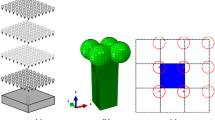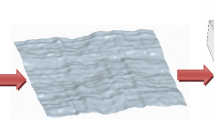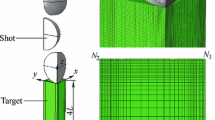Abstract
Finite element method (FEM) has been proved to be powerful in studying the process of shot peening (SP). The random representative cell model is frequently utilized to simulate the SP process more realistically. In order to investigate the sensitivity of the random representative cell models to the finite element simulation results of the SP-induced stress field, Almen arc height, and surface roughness, the three-dimensional random representative cell model was developed to simulate the process of SP of Almen strip, and the SP-induced stress field and surface roughness were analyzed resultantly. A novel numerical calculation framework linking the random representative cell model with the finite element model of the whole Almen strip was further proposed to calculate the SP-induced Almen arc height, and the numerical prediction results of the Almen intensities are in good agreement with the experimental data with regard to the shot velocities of 30 m/s, 50 m/s, and 100 m/s. The effects of the shot velocity and SP coverage on the sensitivity of the random representative cell models to the simulation results of SP were accordingly discussed comprehensively and systematically.


















Similar content being viewed by others
Availability of data and materials
The authors confirm that the data supporting the findings of this study are available within the article.
References
Soyama H, Chighizola CR, Hill MR (2021) Effect of compressive residual stress introduced by cavitation peening and shot peening on the improvement of fatigue strength of stainless steel. J Mater Process Tech 288:116877. https://doi.org/10.1016/j.jmatprotec.2020.116877
Unal O, Maleki E, Karademir I, Husem F, Efe Y, Das T (2022) Effects of conventional shot peening, severe shot peening, re-shot peening and precised grinding operations on fatigue performance of AISI 1050 railway axle steel. Int J Fatigue 155:106613. https://doi.org/10.1016/j.ijfatigue.2021.106613
Nordin E, Alfredsson B (2016) Measuring shot peening media velocity by indent size comparison. J Mater Process Tech 235:143–148. https://doi.org/10.1016/j.jmatprotec.2016.04.012
Ohta T, Tsutsumi S, Ma NS (2021) Direct measurement of shot velocity and numerical analysis of residual stress from pneumatic shot peening. Surf Interfaces 22:100827. https://doi.org/10.1016/j.surfin.2020.100827
Torres M, Voorwald H (2002) An evaluation of shot peening, residual stress and stress relaxation on the fatigue life of AISI 4340 steel. Int J Fatigue 24:877–886. https://doi.org/10.1016/S0142-1123(01)00205-5
Bag A, Delbergue D, Ajaja J, Bocher P, Levesque M, Brochu M (2020) Effect of different shot peening conditions on the fatigue life of 300 M steel submitted to high stress amplitudes. Int J Fatigue 130:105274. https://doi.org/10.1016/j.ijfatigue.2019.105274
Wang C, Wu G, He T, Zhou YJ, Zhou ZC (2020) Numerical study of fatigue crack propagation in a residual stress field induced by shot peening. J Mater Eng Perform 29:5525–5539. https://doi.org/10.1007/s11665-020-05029-9
Wang C, Lai YB, Wang L, Wang CL (2020) Dislocation-based study on the influences of shot peening on fatigue resistance. Surf Coat Tech 383:125247. https://doi.org/10.1016/j.surfcoat.2019.125247
Kovaci H, Bozkurt YB, Yetim AF, Aslan M, Celik A (2019) The effect of surface plastic deformation produced by shot peening on corrosion behavior of a low-alloy steel. Surf Coat Tech 360:78–86. https://doi.org/10.1016/j.surfcoat.2019.01.003
Wang C, Wang L, Wang XG, Xu YJ (2018) Numerical study of grain refinement induced by severe shot peening. Int J Mech Sci 146:280–294. https://doi.org/10.1016/j.ijmecsci.2018.08.005
Wang C, Wang CL, Wang L, Lai YB, Li K, Zhou YJ (2020) A dislocation density-based comparative study of grain refinement, residual stresses, and surface roughness induced by shot peening and surface mechanical attrition treatment. Int J Adv Manuf Tech 108:505–525. https://doi.org/10.1007/s00170-020-05413-8
Maleki E, Bagherifard S, Unal O, Bandini M, Farrahi GH, Guagliano M (2021) Introducing gradient severe shot peening as a novel mechanical surface treatment. Sci Rep 11(1):1–13. https://doi.org/10.1038/s41598-021-01152-2
Martin V, Vazquez J, Navarro C, Dominguez J (2020) Effect of shot peening residual stresses and surface roughness on fretting fatigue strength of Al7075-T651. Tribol Int 142:106004. https://doi.org/10.1016/j.triboint.2019.106004
Taro M, Chaise T, Nelias D (2015) A methodology to predict the roughness of shot peened surfaces. J Mater Process Tech 217:65–76. https://doi.org/10.1016/j.jmatprotec.2014.10.016
Llaneza V, Belzunce FJ (2015) Study of the effects produced by shot peening on the surface of quenched and tempered steels: roughness, residual stresses and work hardening. Appl Surf Sci 356:475–485. https://doi.org/10.1016/j.apsusc.2015.08.110
Unal O, Varol R (2015) Surface severe plastic deformation of AISI 304 via conventional shot peening, severe shot peening and repeening. Appl Surf Sci 351:289–295. https://doi.org/10.1016/j.apsusc.2015.05.093
Maleki E, Unal O, Kashyzadeh KR (2019) Efficiency analysis of shot peening parameters on variations of hardness, grain size and residual stress via taguchi approach. Met Mater Int 25:1436–1447. https://doi.org/10.1007/s12540-019-00290-7
Maleki E, Unal O, Kashyzadeh KR (2021) Influences of shot peening parameters on mechanical properties and fatigue behavior of 316 l steel: experimental, taguchi method and response surface methodology. Met Mater Int 27:4418–4440. https://doi.org/10.1007/s12540-021-01013-7
Trung PQ, Khun NW, Butler DL (2016) Effects of shot peening pressure, media type and double shot peening on the microstructure, mechanical and tribological properties of low-alloy steel. Surf Topogr Metrol Prop 4:045001. https://doi.org/10.1088/2051-672x/4/4/045001
Ghasemi A, Hassani-Gangaraj SM, Mahmoudi AH, Farrahi GH, Guagliano M (2016) Shot peening coverage effect on residual stress profile by FE random impact analysis. Surf Eng 32:861–870. https://doi.org/10.1080/02670844.2016.1192336
Pham TQ, Khun NW, Butler DL (2017) New approach to estimate coverage parameter in 3D FEM shot peening simulation. Surf Eng 33:687–695. https://doi.org/10.1080/02670844.2016.1274536
Lin QJ, Liu HJ, Zhu CC, Parker RG (2019) Investigation on the effect of shot peening coverage on the surface integrity. Appl Surf Sci 489:66–72. https://doi.org/10.1016/j.apsusc.2019.05.281
Wu JZ, Liu HJ, Wei PT, Zhu CC, Lin QJ (2020) Effect of shot peening coverage on hardness, residual stress and surface morphology of carburized rollers. Surf Coat Tech 384:125273. https://doi.org/10.1016/j.surfcoat.2019.125273
Almen JO, Black PH, Dolan TJ (1963) Residual stresses and fatigue in metals. J Appl Mech 31:368. https://doi.org/10.1115/1.3629645
Yang Z, Park JS, Lee Y (2014) A strip holding system for finite element simulation of Almen strip testing. J Mech Sci Technol 28:2825–2830. https://doi.org/10.1007/s12206-014-0636-y
Gonzalez J, Bagherifard S, Guagliano M, Pariente IF (2017) Influence of different shot peening treatments on surface state and fatigue behaviour of Al 6063 alloy. Eng Fract Mech 185:72–81. https://doi.org/10.1016/j.engfracmech.2017.03.017
Teo A, Ahluwalia K, Aramcharoen A (2020) Experimental investigation of shot peening: correlation of pressure and shot velocity to Almen intensity. Int J Adv Manuf Tech 106:4859–4868. https://doi.org/10.1007/s00170-020-04982-y
Bagherifard S, Ghelichi R, Guagliano M (2012) On the shot peening surface coverage and its assessment by means of finite element simulation: A critical review and some original developments. Appl Surf Sci 259:186–194. https://doi.org/10.1016/j.apsusc.2012.07.017
Lin QJ, Wei PT, Liu HJ, Zhu JZ, Zhu CC, Wu JZ (2022) A CFD-FEM numerical study on shot peening. Int J Mech Sci 223:107259. https://doi.org/10.1016/j.ijmecsci.2022.107259
Ruiz E, Ferreno D, Cuartas M, Arroyo B, Carrascal IA, Rivas I, Gutierrez-Solana F (2022) Application of machine learning algorithms for the optimization of the fabrication process of steel springs to improve their fatigue performance. Int J Fatigue 159:106785. https://doi.org/10.1016/j.ijfatigue.2022.106785
Unal O (2016) Optimization of shot peening parameters by response surface methodology. Surf Coat Tech 305:99–109. https://doi.org/10.1016/j.surfcoat.2016.08.004
Wang XL, Wang Z, Wu G, Gan J, Yang Y, Huang HM, He JX, Zhong HL (2019) Combining the finite element method and response surface methodology for optimization of shot peening parameters. Int J Fatigue 129:105231. https://doi.org/10.1016/j.ijfatigue.2019.105231
Maleki E, Bagherifard S, Razavi SMJ, Bandini M, du Plessis A, Berto F, Guagliano M (2022) On the efficiency of machine learning for fatigue assessment of post-processed additively manufactured AlSi10Mg. Int J Fatigue 160:106841. https://doi.org/10.1016/j.ijfatigue.2022.106841
Maleki E, Unal O, Guagliano M, Bagherifard S (2022) Analysing the fatigue behaviour and residual stress relaxation of gradient nano-structured 316l steel subjected to the shot peening via deep learning approach. Met Mater Int 28:112–131. https://doi.org/10.1007/s12540-021-00995-8
Mori KI, Osakada K, Matsuoka N (1994) Finite element analysis of peening process with plasticity deforming shot. J Mater Process Tech 45:607–612. https://doi.org/10.1016/0924-0136(94)90406-5
Kim T, Lee H, Hyun HC, Jung S (2013) Effects of Rayleigh damping, friction and rate-dependency on 3D residual stress simulation of angled shot peening. Mater Design 46:26–37. https://doi.org/10.1016/j.matdes.2012.09.030
Xie LC, Wang CX, Wang LQ, Wang Z, Jiang CH, Lu WJ, Ji V (2016) Numerical analysis and experimental validation on residual stress distribution of titanium matrix composite after shot peening treatment. Mech Mater 99:2–8. https://doi.org/10.1016/j.mechmat.2016.05.005
Kim T, Lee JH, Lee H, Cheong SK (2010) An area-average approach to peening residual stress under multi-impacts using a three-dimensional symmetry-cell finite element model with plastic shots. Mater Design 31:50–59. https://doi.org/10.1016/j.matdes.2009.07.032
Wang C, Hu JC, Gu ZB, Xu YJ, Wang XG (2017) Simulation on residual stress of shot peening based on a symmetrical cell model. Chin J Mech Eng 30:344–351. https://doi.org/10.1007/s10033-017-0084-6
Zhang JB, Lu SH, Zhou Z, Wu TR, Xu G (2017) Modeling of multiple shots for analyzing shot peening controlled parameters on formed curvature radius. Int J Adv Manuf Tech 93:1867–1876. https://doi.org/10.1007/s00170-017-0629-y
Matuszak J, Zaleski K, Skoczylas A, Ciecielag K, Kecik K (2021) Influence of semi-random and regular shot peening on selected surface layer properties of aluminum alloy. Materials 14(24):7620. https://doi.org/10.3390/ma14247620
Miao HY, Larose S, Perron C, Levesque M (2009) On the potential applications of a 3D random finite element model for the simulation of shot peening. Adv Eng Softw 40:1023–1038. https://doi.org/10.1016/j.advengsoft.2009.03.013
Hu DY, Gao Y, Meng FC, Song J, Wang YF, Ren MX, Wang RQ (2017) A unifying approach in simulating the shot peening process using a 3D random representative volume finite element model. Chin J Aeronaut 30:1592–1602. https://doi.org/10.1016/j.cja.2016.11.005
Wu JZ, Liu HJ, Wei PT, Lin QJ, Zhou SS (2020) Effect of shot peening coverage on residual stress and surface roughness of 18CrNiMo7–6 steel. Int J Mech Sci 183:105785. https://doi.org/10.1016/j.ijmecsci.2020.105785
Lin QJ, Liu HJ, Zhu CC, Chen DF, Zhou SS (2020) Effects of different shot peening parameters on residual stress, surface roughness and cell size. Surf Coat Tech 398:126054. https://doi.org/10.1016/j.surfcoat.2020.126054
Cao W, Fathallah R, Castex L (1995) Correlation of Almen arc height with residual stresses in shot eening process. Mater Sci Tech-lond 11:967–973. https://doi.org/10.1179/mst.1995.11.9.967
Guagliano M (2001) Relating Almen intensity to residual stresses induced by shot peening: a numerical approach. J Mater Process Tech 110(3):277–286. https://doi.org/10.1016/S0924-0136(00)00893-1
Miao HY, Larose S, Perron C, Levesque M (2010) An analytical approach to relate shot peening parameters to Almen intensity. Surf Coat Tech 205:2055–2066. https://doi.org/10.1016/j.surfcoat.2010.08.105
Bhuvaraghan B, Srinivasan SM, Maffeo B (2011) Numerical simulation of Almen strip response due to random impacts with strain-rate effects. Int J Mech Sci 53:417–424. https://doi.org/10.1016/j.ijmecsci.2011.03.004
Chen Z, Yang F, Meguid SA (2014) Realistic finite element simulations of arc-height development in shot-peened Almen strips. J Eng Mater Technol 136(4):041002. https://doi.org/10.1115/1.4028006
Bobba D, Ramaprabhu P, Cherukuri HP (2019) An integrated DEM-FEM model for shot peening applications. International Manufacturing Science and Engineering Conference, American Society of Mechanical Engineers, 58752: V002T03A054. doi:https://doi.org/10.1115/MSEC2019-2885.
Robertson GT (1971) The effects of shot size on the residual stresses resulting from shot peening. SAE Technical Paper 710284. doi:https://doi.org/10.4271/710284.
Jebahi M, Gakwaya A, Lévesque J, Mechri O, Ba K (2016) Robust methodology to simulate real shot peening process using discrete-continuum coupling method. Int J Mech Sci 107:21–33. https://doi.org/10.1016/j.ijmecsci.2016.01.005
Trung PQ, Butler DL, Idapalapati S (2018) A numerical and experimental study of distribution of the residual stress on the shot peened low alloy steel. J Eng Mater Technol 140(4):041006. https://doi.org/10.1115/1.4040004
Ghanbari S, Bahr DF (2020) Predictions of decreased surface roughness after shot peening using controlled media dimensions. J Mater Sci Technol 58:120–129. https://doi.org/10.1016/j.jmst.2020.03.075
Mylonas GI, Labeas G (2011) Numerical modelling of shot peening process and corresponding products: residual stress, surface roughness and cold work prediction. Surf Coat Tech 205:4480–4494. https://doi.org/10.1016/j.surfcoat.2011.03.080
Bagherifard S, Ghelichi R, Guagliano M (2012) Numerical and experimental analysis of surface roughness generated by shot peening. Appl Surf Sci 258:6831–6840. https://doi.org/10.1016/j.apsusc.2012.03.111
Qiang B, Li YD, Yao CR, Wang X (2018) Effect of shot peening coverage on residual stress field and surface roughness. Surf Eng 34:939–946. https://doi.org/10.1080/02670844.2017.1391939
Funding
The authors are grateful for the supports provided by Anhui Provincial Natural Science Foundation (2008085QE228), Open Fund of Collaborative Innovation Center of High-end Laser Manufacturing Equipment Co-sponsored by Ministry and Province (JGKF-202202) and the Graduate Innovation and Entrepreneurship Fund of Anhui University of Science and Technology (2022CX2067).
Author information
Authors and Affiliations
Contributions
Cheng Wang: conceptualization, funding acquisition, methodology, writing—original draft. Xinrong Tao: numerical simulation, data curation. Kun Sun: Numerical modeling, validation. Senhui Wang: formal analysis, methodology. Kun Li: conceptualization, methodology. Haishun Deng: conceptualization, methodology, supervision. All authors read and approved the final manuscript.
Corresponding author
Ethics declarations
Ethics approval
It is approved that the paper is original and has been written based on the authors’ own finding. All the figures and tables are original, and every expression from other published works were acknowledged and referenced.
Consent to participate
All authors are aware and satisfied of the authorship order and correspondence of the paper.
Consent for publication
All authors are satisfied that the last revised version of the paper is published without any changes.
Competing interests
The authors declare that they have no competing interests.
Additional information
Publisher's Note
Springer Nature remains neutral with regard to jurisdictional claims in published maps and institutional affiliations.
Rights and permissions
Springer Nature or its licensor (e.g. a society or other partner) holds exclusive rights to this article under a publishing agreement with the author(s) or other rightsholder(s); author self-archiving of the accepted manuscript version of this article is solely governed by the terms of such publishing agreement and applicable law.
About this article
Cite this article
Wang, C., Tao, X., Sun, K. et al. On the sensitivity of the three-dimensional random representative finite element model of multiple shot impacts to the SP-induced stress field, Almen intensity, and surface roughness. Int J Adv Manuf Technol 125, 2549–2567 (2023). https://doi.org/10.1007/s00170-023-10892-6
Received:
Accepted:
Published:
Issue Date:
DOI: https://doi.org/10.1007/s00170-023-10892-6




